This post is part of the Cook the Books blog event running until December 15, 2008: read Lily Prior's La Cucina, and cook something inspired by the book. Post your inspiration on your blog, linking to Ioanna's, Deb's and the Cook the Book blog. For those who wish to participate but can't find the book, I am willing to send you my copy (the first to send me their address at my email: mverivaki at hotmail dot com).
WARNING: this post contains a spoiler - if you don't want to know about the story till you have read it, don't read on post!!
Rosa lived in la cucina throughout her whole childhood, which was interrupted by the death of her first love, Bartolomeo. La cucina was the basis of the whole life of la fattoria which belonged to Rosa's family; this was where her mama found her new husband, after overturning barrels of ale and smashing all the preserves jars which Rosa had so lovingly prepared. It was also where Rosa found solace after Bartolomeo's death; the farm could not produce enough harvests to keep up with Rosa's cooking frenzy after that point in her life. Even after Rosa had left la fattoria, the food she had prepared, using up all her own resources from her trousseau, fed her family and more during the war when food was scarce.
Food and the act of eating were the focal points in Rosa's daily life, governing every part of her body and actions. She referred to her thighs as 'loins' and her breasts as 'watermelons'. Her brothers were the 'fruits of (her mother's) womb'. When her lover tore off her corset which fitted her in the manner of a 'vacuum-packed' food package, he delivered her 'naked form like a monstrous pea from its pod.' When she went into her frenetic cooking mode, she woke up the whole house with her 'nocturnal thrusts as I pounded the dough'. Even the rain was like 'fat slippery drops'. Her eyes 'feasted' on something delectable, while her heart felt 'crushed like a clove of garlic' when she was upset.
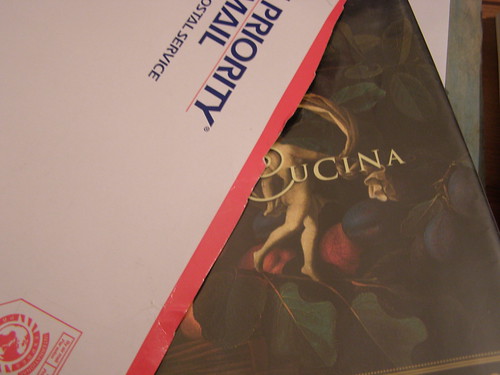
I begged Rachel from Old Saratoga Books to give me her copy of La Cucina for the Cook the Books event.
La cucina was also where the full range of olfactory sensations resided, all the aromas once can imagine pervading the air of a pre-WWII Sicilian kitchen: freshly brewed coffee, nutmeg, vanilla, the milky smell of the many babies mama bore, old leather, sheep's cheese, violets, stale tobacco, the smell of death, and most of all, of proving dough, which was worked with Rosa's hands into all shapes of pasta: ravioli, spirali, rigatoni, spaghetti, cannelloni; and all manner of bread: ciabatta, focaccia, pane rimacinato.
Sex smelt, tasted and felt like food: musky, salty, pungent. Menstruation was believed by Rosa to be the effect of eating too many artichokes. As she drifted into a lemon-flavoured sleep, she went shopping at the market naked, while her lover's hands were as light as a zabaglione. The office girls dressed like tarts, while she blushed like a beetroot when she saw her lover.
The delights of the Sicilian cuisine need no exultation, suffice it to say that Rosa tempts the reader's tastebuds with honey walnut cookies, panelle (chickpea fritters), pomodoro (tomato sauce), pig blood sausages, dolci, cassata, nucatoli, torta, frittedda, formaggio alla Argentiera, pollo alla Mesinese, pasta alla Norma, pasta con acciughe e mollica, maccu (fava), and torta di ricotta, among the many other dishes she mentions and describes. Food forms a part of nearly every page in the book, using the technique in which parts of the story are narrated by actually giving us a recipe. Any food lover will be able to recreate reasonable versions of pasticcio do Sostanza, tonno alla Siracusa or Sicilian 'strattu (if they can find enough tomatoes, that is) by reading the appropriate parts of La Cucina.
Sicilian cooking was heavily influenced by the Greeks, among the many other races that had also occupied the island (the Romans, Phoenicians, Arabs and Normans). The proximity of Crete to Sicily, coupled with the fact that they are both islands, enhances the possibility of a similarity in the temperament of the people that live there. The way Rosa cooks reminds me so much of myself. I am always involved in a cooking frenzy - as a working mother and wife of a demanding Cretan (read: Sicilian) husband, sourcing fresh ingredients and cooking take up most of my free hours when I am not at work or with the children.
I find it totally natural that food seeps into every part of her life, as it does in Crete. Rosa's sex life is a conjoining of loins rubbing against each other; there is an old adage in Greek that the best way to a man’s heart is through his stomach. Her lover admits that 'amore e cucina complement each other', and 'eating is akin to lovemaking.' Rosa’s cucina antics are like an orgy; in Crete, cooking is an all-or-nothing activity, involving a huge amount of effort on the part of the cook (both in terms of cooking and cleaning up afterwards), only for the meal she prepared to be scoffed up in next to no time - the end finale of the act...
Rosa's favorite pastime before she goes to work is to search for the best ingredients, also a task of immense importance in my own kouzina (as we call it in Greek), at the instigation of my gourmet husband; my daughter has picked up the gourmet gene from her father, and can tell, even at her youthful age of six, what is ‘right’ and what is not in her mama’s kitchen...
*** *** ***
I was recently given a huge pumpkin by my uncles who grow everything imaginable in their garden: besides the traditional Greek vegetables, they grow kohlrabi, green cauliflower and finnocchio, among others. As it sat in a corner of the kitchen balcony, I wondered what Rosa would have done with it; pumpkin was not mentioned in the book.Mine started off being added to cake, then it was turned into cookies and a pie, and there was still the other half to be used up. Roasted pumpkin becomes soft and pliable, making it perfect for adding to dough. While Rosa was living in la fattoria, she was making dough nearly every day, kneading it into bread and cutting it into all sorts of pasta shapes. Rosa's kitchen madness descended on me: I threw an egg into the pumpkin mash and began mixing it in, the slimy goo squelching in the palms of my hand, the egg whites oozing through my fingers. Once I started mixing the seasoned flour into the mud pool, my movements becoming more rhythmic, and the mixture felt more familiar to me.
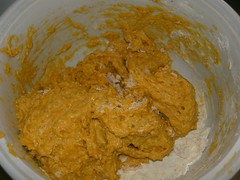
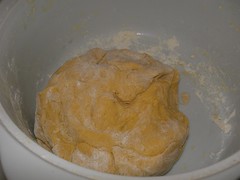
(1 cup of pumpkin puree, 1 egg, 2 tablespoons of olive oil, salt and pepper, 2 cups of flour, more flour for dusting)
...I suddenly remembered my mother's pastry machine, hidden away in a corner cupboard of my kitchen. There was one part of the machine which had never ever been used, not in Wellington, where the pastry machine was bought and first used to roll out the pastry for my mother's kalitsounia, nor in Greece, where I took it into my home, once I inherited it on my mother's passing. The 'pastry' machine was actually a lasagne and pasta maker, made in Milano, and purchased by special order by my mother in New Zealand. It amazes me now that the pasta cutter, which had never found a use in our home, was still in the original box; we were Cretans, not Sicilians, and we never made pasta.
Rosa's cucina inspired me to make my own pasta from the pumpkin gnocchi dough I had been kneading. Home-made fettuccine contains similar ingredients to gnocchi (see Ioanna's recipe, which includes step-by-step instructions on how to make the pasta). I placed the gnocchi onto a flat tray and put it in the deep freeze; the gnocchi would have to be eaten on another day, not today, when, at Rosa's inspiration, I had an urge to use my mother's pasta machine. I kneaded the dough till it was evenly soft and pliable, then set up the machine on the kitchen worktop. By constantly dusting the pastry with flour, I was able to keep it from becoming sticky and breaking up. The smell of the dough wafted through the rooms of the house.
"What's that dough for, Mum? Biscuits, pizza?" The children had detected the aroma of freshly kneaded dough, and came to investigate. They watched in amazement as the long flat piece of dough came out of the other end in long even strips, which I hung on a clothes hanger. The pasta smelt heavenly; the kitchen had been transformed into a scented bakery. The flour particles were being spread around the kitchen, coating everything snowy white. The children searched the benchtop for some dough scraps to play with, but were disappointed. Pasta making is very efficient in that all the dough can be kneaded back into the main mixture, leaving very little waste.
Time was running out; il marito was due to return from work soon, and all I had prepared was the pasta. What sauce could I tempt him with that needed the minimum of time and the simplest of ingredients to make? I found the answer in my well-stocked larder: an unopened jar of capers which I had pickled in June, a jar of tomato sauce made in August, garlic from the garden, and a jar of thick black store-bought Kalamata olives. Along with the staples of olive oil, salt and pepper, this could only mean one thing: a saucy puttanesca, its aromatic steam invading the nostrils, numbing the mind senseless, the most appropriate sauce after an orgiastic frenzy in ma cucina...
I like this photo of my children enjoying their pasta plain with freshly grated parmesan.
There was enough pasta left over for at least another two people. I decided to hold back from cooking it all at once, lest my stomach became overly full; we all know what happened to Rosa after she served her lover that sumptuous timbalo. I froze it along with the gnocchi, for a more subdued meal later in the week. The garden is still being over-productive in the eggplant department: perfect for a pasta alla Norma, another of Rosa's culinary masterpieces; as one of her neighbours remarked: "She may be a whore, but she knows how to cook."
©All Rights Reserved/Organically cooked. No part of this blog may be reproduced and/or copied by any means without prior consent from Maria Verivaki.

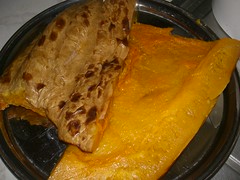
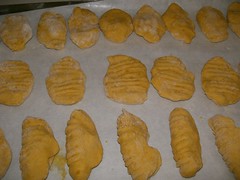
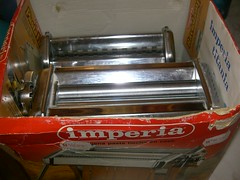

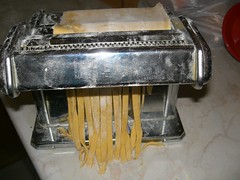

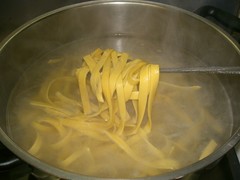

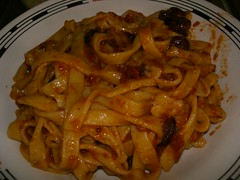
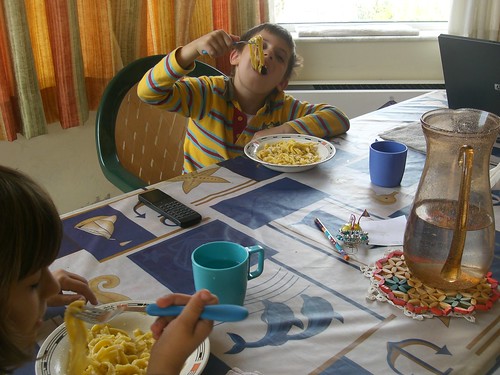
That's really impressive Maria..love the idea of pumpkin fettucine with that "salty" puttanesca. An absolute treat and blend of flavours. Glad to see the book has you inspired! (and how I envy that over productive garden of yours).
ReplyDeleteMagnifico! I really enjoyed your book descriptions and the Pumpkin Pasta alla Puttanesca is just great. Love this post and am happy to see that the Cook the Books book club has such a nice global readership.
ReplyDeleteFeel free to pass on the book to another reader. I got it in New York from my mom in Florida who bought it at a library book sale, so it has already had an interesting history. The more readers the merrier!
That pasta looks absolutely amazing!! Love the simple sauce also and way to think on your feet.
ReplyDeleteMaria, very resourceful and bravo on the pasta making. The sweet pasta and the zesty puttanesca sound wonderful together.
ReplyDeleteIf you were with me, you would have heard my stomach growling as I neared the end of your post. Your version of pasta puttanesca looks and sounds fabulous! Plus, your review of La Cucina really did it justice - it's a great book for anyone who loves good food. I've been wondering how to participate in Cook the Books since my copy is in Greece - but now you've inspired me!
ReplyDeleteWow, that pasta looks amazing! I know Sicilian cuisine is so diverse and really so very different from other regional Italian dishes! Thanks for this post about this lovely book!
ReplyDeletewow Maria, you have really taken pumpkin to a whole new level.. Way more creative than in the US. Most people throw their pumpkins away after Halloween.
ReplyDeleteI am going to order LaCusina from Amazon.
I just finished The Wedding Officer, which was along the same lines.
Cooking, sex, war, all the good things a novel can have:)
fresh homemade pasta sounds delicious! This is an inspiration! :)
ReplyDeleteI love your pasta machine, Maria. Can you buy those in Xania?
ReplyDeleteRay
Just a small correction to your comment.
ReplyDeletePinnekjøtt is a Norwegian dish.
NOT swedish
:)
WOW! I hope my recipe for pasta helped! I didn't read the post as it contains spoilers, but I love your dish. Thanks again for the link
ReplyDeleteTo be so inspired Maria.
ReplyDeleteInteresting description of the book,well written.
ReplyDeleteDelicious fresh home made pasta with pumpkins ,adorable kids:)